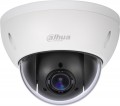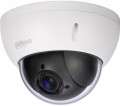Matrix size
The size of the matrix installed in the surveillance camera (diagonally).
In general, larger sensors (with the same resolution and sensor type) are considered more advanced: they get more light, which has a positive effect on image quality (especially in low light). On the other hand, increasing the size affects the cost of the entire device; and in some cases (for example, if the camera is not planned to be used in twilight and darkness), a relatively small sensor may be quite suitable.
As for specific dimensions, the most modest cameras in terms of this indicator have matrices of
1/4 "or less. Models with sensors of
1/3.8" - 1/3" and
1/2.9" - 1/2" are very popular, these values can be called average. And in advanced devices, diagonals and
more than 1/2 "(up to 1/1.7") are found.
Signal to noise ratio
The signal-to-noise ratio that the surveillance camera corresponds to.
This indicator describes the ratio of the level of the useful signal (the actual image produced by the camera to an external device) to the level of extraneous noise that inevitably arises during the operation of electronic circuits. Such noise appears in the image as characteristic noise (“snow”). The higher the signal-to-noise ratio, the less interference on the screen, the clearer and better the image is, and the smaller the volume of recorded video files. It is believed that visible noise practically disappears at a ratio of at least 45 dB. However, among modern cameras there are also higher rates.
Backlight compensation
—
WDR (Wide Dynamic Range) — extended dynamic range. WDR technology combines several frames with different exposures into one picture, as a result, dark areas are brightened, and overexposures are darkened, and the output is a picture with extremely uniform lighting. The true wide dynamic range technology is called True-WDR and it is implemented in the optical circuit at the hardware level, a special microprocessor is responsible for creating and mixing exposures. A more affordable alternative to wide dynamic range is Digital-WDR technology, which equalizes lighting through software algorithms.
—
DWDR (Digital Wide Dynamic Range) — extended dynamic range technology based on software brightening algorithms. DWDR brightens too dark areas of the frame, which can be completely blurred against the background of light areas. Digital brightening allows you to noticeably improve the quality of shooting in contrasting lighting conditions. Digital WDR cameras are noticeably cheaper than true True-WDR optics. Of course, the quality of digital brightening is inferior to True-WDR.
—
BLC (Back Light Compensation) — backlight compensation technology. This system is based on the work of digital signal processors DSP. So, the device, relatively speaking, "breaks" the frame into many segments, making its own adjustments to each of them. Backlight compensation brightens dark areas of
...the frame well. The main disadvantage of the technology is the increase in the brightness of the already bright areas of the frame, due to which overexposure may appear in the picture.
— WDR+BLC. The camcorder supports several lightening technologies at once, each of which is described in more detail above. Immediately, we note that the combination of WDR + BLC allows you to achieve an extremely clear and clear picture in almost any lighting conditions, from extreme contrast to insufficient and excessively bright.
— DWDR+BLC. The device supports two popular clarification technologies at once, each of which is described in more detail above. The presence of DWDR + BLC technologies allows the camera to effectively brighten the dark areas of the frame. Such video cameras have proven themselves well when working in low light conditions.Vertical viewing angle
Vertical viewing angle of the surveillance camera. In models with a variable value, the maximum is indicated, and the angle when zooming is not so important.
The wider the viewing angle, the more space the camera captures and at the same time, the smaller the images of individual objects in the frame are obtained. Therefore, when choosing by this parameter, it is worth deciding what is more important – the ability to view a large scene or the visibility of small details in a relatively narrow field of view.
Power consumption
The power consumed by CCTV cameras during operation. Knowing the indicator of energy consumption, you can, for example, calculate the battery life of equipment from an uninterruptible power supply or choose a suitable “uninterruptible power supply”. Also, with the support of PoE technology, it is worth considering the power consumption when choosing a PoE switch or PoE adapter.
Maximum humidity
The highest relative humidity at which the camera is able to operate normally, without failures and breakdowns, for an unlimited time.
Modern electronics tolerate low humidity well, but high rates affect it negatively — with a long stay in such an atmosphere, moisture can condense on certain parts of the structure and various unpleasant consequences, from corrosion to short circuits and fires. Therefore, you can use the camera effectively and safely only in conditions where the humidity does not exceed the maximum recommended value specified in the specifications. At the same time, we note that many devices are able to endure short-term (up to several hours) exposure to high humidity without consequences.

